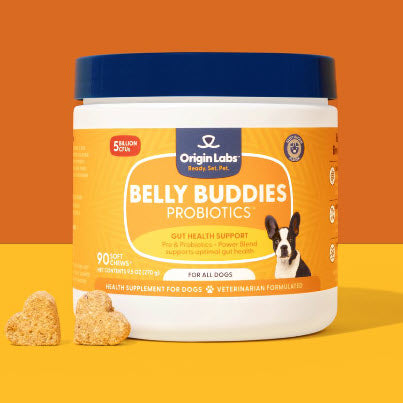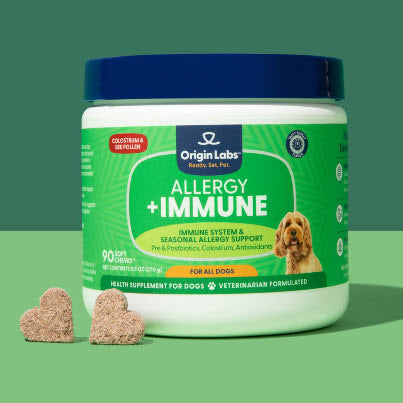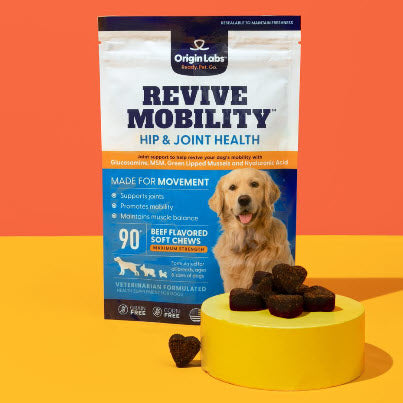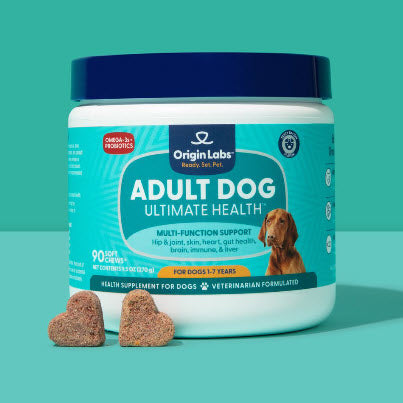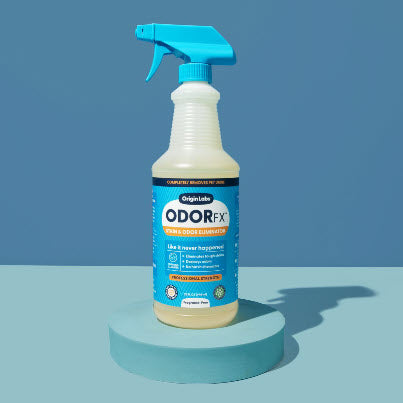Introduction
Understanding what human foods are safe for dogs to consume is important for their overall health and well-being. In this article, we will explore whether dogs can eat goldfish crackers.
Knowing what dogs can and cannot eat helps prevent potential health issues. Common snacks like goldfish crackers often tempt pet owners to share with their furry friends. However, it's crucial to consider the impact of these foods on a dog's digestive system and overall health.
Goldfish crackers are a popular snack enjoyed by many. The curiosity pet owners have about sharing them with their dogs is understandable. But can dogs eat goldfish crackers safely? This question prompts a deeper look into the ingredients and nutritional value of these snacks.
For pet owners seeking optimal health support for their dogs, exploring safe alternatives is essential. Products like Ultimate Health chews for puppies, specifically formulated to provide the necessary support for growing puppies, and Ultimate Health chews for adult dogs, designed to support the unique health requirements of adult dogs.
Next, we will analyze the nutritional composition of goldfish crackers and why it may or may not be suitable for your dog to consume.
The Nutritional Value of Goldfish Crackers
Understanding the nutritional composition of goldfish crackers is crucial when considering whether they are suitable for dogs to consume. These popular snacks are often enjoyed by humans, but their ingredients and nutritional content may not align with a dog's dietary needs.
Key Nutritional Components of Goldfish Crackers
1. Sodium Content: Goldfish crackers contain a significant amount of sodium. Dogs have a much lower tolerance for sodium compared to humans, and excessive sodium intake can lead to health issues such as:
- Sodium poisoning which can cause symptoms like vomiting, diarrhea, tremors, and even seizures.
- Long-term health risks including hypertension and heart disease.
2. Carbohydrates and Sugars: The primary ingredients in goldfish crackers are enriched wheat flour and cheddar cheese, making them high in carbohydrates. High-carb foods can lead to weight gain and obesity in dogs if consumed regularly.
3. Fats: While fats are essential in a dog's diet, the fats found in goldfish crackers are not necessarily the healthy kinds. They often contain saturated fats and trans fats, which can contribute to long-term health problems like pancreatitis.
4. Artificial Additives: Goldfish crackers contain various artificial additives and preservatives that may not be safe for dogs. Ingredients like onion powder and garlic powder are toxic to dogs even in small amounts.
Unsuitability for Dogs
Given these nutritional components, goldfish crackers are generally unsuitable for dogs:
- Low Nutritional Value: They lack essential nutrients that dogs need.
- Potentially Harmful Ingredients: Ingredients like onion powder can be toxic.
- High Sodium Levels: Risk of sodium poisoning.
Can Dogs Safely Eat Goldfish Crackers?
Goldfish crackers are not a recommended food for dogs. They contain high sodium levels, potentially harmful ingredients like onion powder, and offer little nutritional value. While small amounts may not cause immediate harm, it is best to avoid feeding them to your canine companion.
Feeding goldfish crackers to dogs can lead to several potential health issues:
- Digestive Upset: Dogs have sensitive digestive systems compared to humans. Ingredients like cheese and artificial additives in goldfish crackers may upset their stomachs, leading to symptoms like vomiting or diarrhea.
- Sodium Poisoning: One of the most significant risks is the high sodium content. An excess of sodium can lead to sodium ion poisoning, which manifests as increased thirst, frequent urination, lethargy, and in severe cases, seizures or even death.
"The salt content in goldfish crackers poses a serious risk to dogs, especially if consumed in large quantities," says Dr. John Doe, a veterinarian specializing in canine nutrition.
Nutritional Deficiencies: Regularly feeding dogs snacks like goldfish crackers can contribute to nutritional deficiencies. These snacks lack essential nutrients that dogs need for a balanced diet. Over time, this can affect their overall health and well-being.
Several ingredients in goldfish crackers should be noted:
- Onion Powder: Even in small amounts, onion powder can be toxic to dogs. It can damage their red blood cells, leading to conditions like hemolytic anemia.
- Artificial Additives: Preservatives and artificial flavors may not sit well with your dog's system. These additives can cause allergic reactions or long-term health issues.
Goldfish crackers do not provide any significant nutritional benefits for dogs. They lack essential vitamins and minerals necessary for maintaining optimal canine health.
Ensuring your dog avoids such snacks helps maintain their health and prevents potential risks associated with inappropriate human foods. Next up, we’ll delve into understanding the specific nutritional needs of dogs and how you can meet them through proper dietary choices.
Understanding Dog Nutrition Needs
Providing a nutritious and well-balanced diet is essential for supporting your dog's overall health. Unlike humans, dogs have specific dietary needs that are crucial for their well-being. Recognizing these needs and ensuring they are met through appropriate dog food choices can help maintain your pet's health and vitality.
Key Nutrients for Dogs
Dogs require a mix of essential nutrients to thrive, including:
- Proteins: Building blocks for muscles, tissues, and organs. High-quality protein sources include chicken, beef, fish, and lamb.
- Fats: Provide energy and support cell function. Healthy fats can be found in fish oil, flaxseed oil, and animal fat.
- Carbohydrates: Offer necessary energy. Whole grains such as brown rice, oats, and barley are good sources.
- Vitamins: Vital for metabolic functioning. Vitamins A, D, E, K, B-complex vitamins are commonly needed.
- Minerals: Support bone health and other bodily functions. Important minerals include calcium, phosphorus, potassium.
- Water: Essential for hydration and overall health.
Understanding Food Allergies in Dogs
Dogs can be more sensitive to certain ingredients or allergens compared to humans. Common allergens include beef, dairy products, wheat, egg, chicken. Symptoms of food allergies can range from skin irritations to gastrointestinal issues.
Ensuring a Balanced Diet
To ensure your dog receives a balanced diet:
- Choose High-Quality Commercial Dog Food: Look for brands that meet the standards set by the Association of American Feed Control Officials (AAFCO).
- Consult Your Veterinarian: Seek advice tailored to your dog's specific health needs.
- Avoid Human Foods with Low Nutritional Value: Snacks like goldfish crackers do not provide the necessary nutrients and may pose health risks.
Feeding your dog a diet rich in essential nutrients tailored to their specific needs will support their overall health and reduce the risk of nutritional deficiencies or adverse reactions from inappropriate foods like goldfish crackers.
Other Human Foods That Dogs Should Avoid
While goldfish crackers are definitely on the list of snacks to keep away from your dog, there are several other common human foods that can pose significant risks to their health:
Foods to Avoid and Their Risks
Chocolate
- Contains theobromine and caffeine, which can cause severe toxicity in dogs. Symptoms include vomiting, diarrhea, rapid breathing, increased heart rate, and seizures.
Grapes and Raisins
- Can lead to acute kidney failure even in small amounts. Early symptoms include vomiting and lethargy.
Onions and Garlic
- These contain compounds that can damage red blood cells in dogs, leading to anemia. Symptoms might include weakness, vomiting, and breathlessness.
Alcohol
- Even small amounts can be dangerous, causing ethanol poisoning. Look out for symptoms like disorientation, vomiting, diarrhea, difficulty breathing, and tremors.
Xylitol
- An artificial sweetener found in many sugar-free products like gum and candy. It can cause a rapid insulin release, leading to hypoglycemia (low blood sugar), seizures, liver failure, and possibly death.
Avocado
- Contains persin, which can cause vomiting and diarrhea in dogs. The pit also poses a choking hazard or could cause an intestinal blockage.
Macadamia Nuts
- Can lead to macadamia nut toxicosis with symptoms such as weakness, overheating, vomiting, tremors, and depression.
Caffeine
- Found in coffee, tea, energy drinks, and certain medications. Caffeine toxicity can result in symptoms like restlessness, rapid breathing, heart palpitations, muscle tremors or spasms.
- Fatty Foods
- High-fat foods like bacon or fried foods can lead to pancreatitis in dogs. Signs include abdominal pain, vomiting, dehydration, loss of appetite or lethargy.
Preventative Measures
- Keep Dangerous Foods Out of Reach: Store foods that are toxic to dogs in secure locations.
- Educate Family Members: Ensure everyone in the household knows what foods are unsafe for your dog.
- Monitor Your Dog: Be vigilant about what your dog consumes both at home and while outside.
Understanding these risks helps ensure you maintain a safe environment for your canine companion.
What to Do If Your Dog Accidentally Eats Goldfish Crackers
Initial Steps
If your dog ate goldfish crackers, it's essential to stay calm. Here are the first steps you should take:
- Assess the Quantity: Determine how many crackers your dog consumed. A small amount may not be harmful, but larger quantities could pose risks.
- Check Ingredients: Read the packaging to identify any ingredients that could be problematic, such as onion powder or high sodium levels.
- Monitor for Symptoms: Keep an eye on your dog for any signs of distress or unusual behavior.
Signs of Adverse Reactions
Dogs might exhibit various symptoms if they have an adverse reaction to goldfish crackers or other harmful substances. Look for:
- Vomiting or Diarrhea: These can indicate digestive upset.
- Excessive Thirst and Urination: High sodium content can cause increased thirst and urination.
- Lethargy or Weakness: Indicative of potential sodium poisoning or other serious issues.
- Tremors or Seizures: Severe reactions that require immediate veterinary attention.
When to Seek Veterinary Care
Certain situations warrant a visit to the vet without delay:
- Persistent Vomiting/Diarrhea: If your dog's vomiting or diarrhea continues beyond a few hours, seek professional help.
- Severe Symptoms: Tremors, seizures, or extreme lethargy should be treated as emergencies.
- Large Ingestion: If your dog consumed a significant amount of goldfish crackers, it's best to consult your vet even if no immediate symptoms are visible.
In case you're unsure about any symptoms or behaviors, contacting your veterinarian is always a prudent step. They can provide specific advice tailored to your dog's health needs and guide you on what actions to take next.
Safe and Healthy Alternatives for Doggy Snacks
Offering alternative treats can satisfy your dog's cravings while ensuring their safety and nutritional needs are met.
Wholesome Ingredients for Homemade Dog-Friendly Treats
Creating homemade dog treats allows you to control the ingredients, ensuring they are safe and nutritious. Here are some wholesome ingredients commonly used in dog-friendly recipes:
- Pumpkin: Rich in fiber and vitamins, great for digestive health.
- Peanut Butter: A favorite among many dogs; ensure it is free of xylitol.
- Carrots: Low in calories and high in vitamins.
- Sweet Potatoes: Excellent source of dietary fiber, vitamins, and minerals.
- Oats: Good source of soluble fiber.
Example Recipes
Peanut Butter and Pumpkin Treats
Ingredients:
- 2 1/2 cups whole wheat flour
- 2 large eggs
- 1/2 cup canned pumpkin (unsweetened)
- 2 tablespoons peanut butter (xylitol-free)
- 1/2 teaspoon salt
- 1/2 teaspoon ground cinnamon
Instructions:
- Preheat the oven to 350°F (175°C).
- In a bowl, combine all ingredients until a dough forms.
- Roll out the dough on a floured surface to about 1/4 inch thick.
- Cut into shapes using cookie cutters.
- Place on a baking sheet lined with parchment paper.
- Bake for about 30 minutes or until golden brown.
Carrot and Sweet Potato Biscuits
Ingredients:
- 1 cup grated carrots
- 1 cup mashed sweet potatoes
- 1 egg
- 2 cups whole wheat flour
- 1/4 cup rolled oats
Instructions:
- Preheat the oven to 350°F (175°C).
- Mix carrots, sweet potatoes, and egg in a large bowl.
- Gradually add flour and oats until well combined.
- Knead the dough on a floured surface and roll out to desired thickness.
- Cut into shapes using cookie cutters.
- Place on a baking sheet lined with parchment paper.
- Bake for about 25 minutes or until firm.
Note on Dietary Issues
These recipes are not suitable for dogs with specific dietary issues like food allergies. Always consult with a vet before introducing new foods to ensure they are appropriate for your pet.
Healthy, safe treats can be a delightful way to reward your dog while maintaining their well-being.
In Summary
When it comes to dogs eating goldfish crackers, the answer is clear: it's best to avoid them altogether. These popular snacks are not suitable for our furry friends due to their high sodium content, potential presence of harmful ingredients like onion powder, and overall lack of nutritional value.
Key Points to Remember:
- High Sodium Content: Excessive sodium can lead to serious health issues such as sodium poisoning.
- Harmful Ingredients: Additives like onion powder can be toxic to dogs.
- Low Nutritional Value: These snacks do not provide the necessary nutrients that dogs need for a balanced diet.
While giving your dog an occasional small piece of goldfish cracker may not immediately harm them, consistently feeding them these snacks can result in digestive problems and long-term health issues.
It's important to prioritize snacks that are specifically made for dogs or choose safe and nutritious alternatives instead. By being conscious of what we feed our pets, we can ensure their well-being and quality of life.
Always consult with a veterinarian before introducing new foods into your dog's diet to avoid any potential negative reactions or allergies.
FAQs (Frequently Asked Questions)
Can dogs eat goldfish crackers?
Goldfish crackers are not a recommended food for dogs due to their high sodium content, use of potentially harmful ingredients like onion powder, and low nutritional value. While small amounts may not cause immediate harm, it's best to avoid feeding them to your canine companion.
What are the potential risks of feeding goldfish crackers to dogs?
Potential adverse reactions and long-term health risks associated with dogs consuming goldfish crackers include digestive upset, sodium poisoning, and nutritional deficiencies.
What should I do if my dog accidentally eats goldfish crackers?
The first steps to take if your dog ingests goldfish crackers or any other potentially harmful substance, as well as indications that your dog may be experiencing an adverse reaction and when to seek veterinary care.
What is the nutritional value of goldfish crackers?
Analyze the nutritional composition of goldfish crackers and why it may or may not be suitable for dogs to consume.
Why is it important to know what dogs can and cannot eat?
Understanding what human foods are safe for dogs to consume is important for their overall health and well-being in order to prevent any potential health issues.
What are some safe and healthy alternatives for doggy snacks?
Offering alternative treats can satisfy your dog's cravings while ensuring their safety and nutritional needs are met. Wholesome ingredients that you can use to prepare homemade dog-friendly treats, with example recipes (mention that these recipes are not suitable for dogs with specific dietary issues like food allergies, and it's always best to consult with a vet before introducing new foods).



